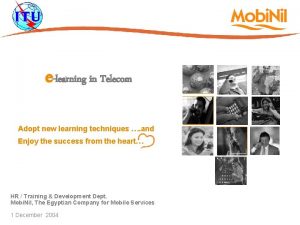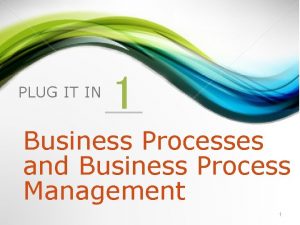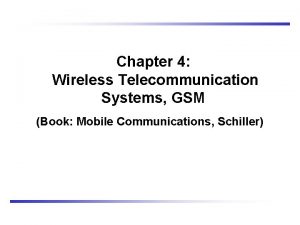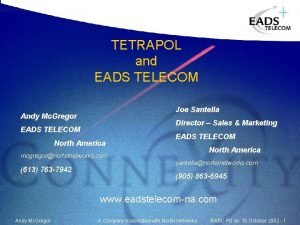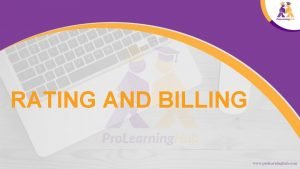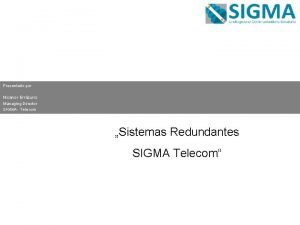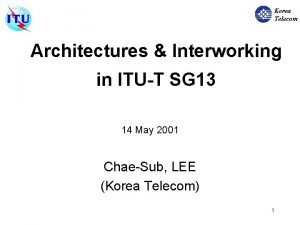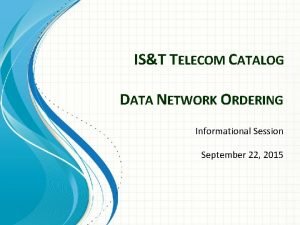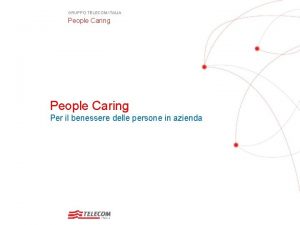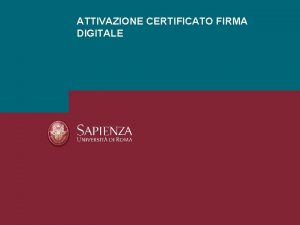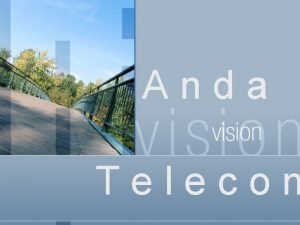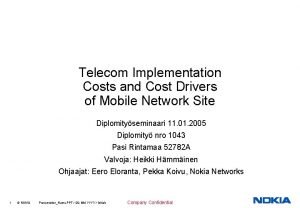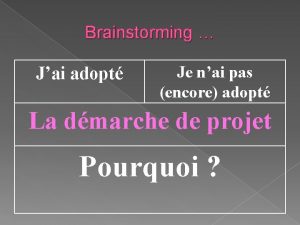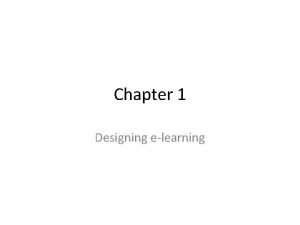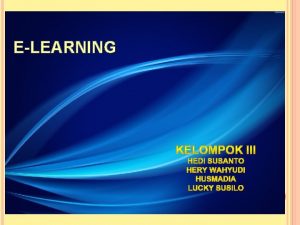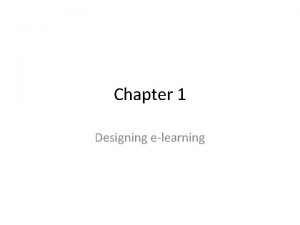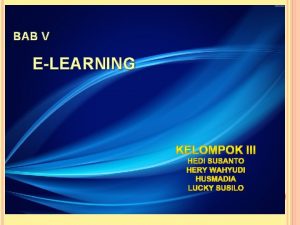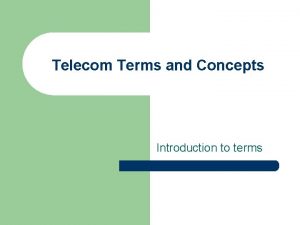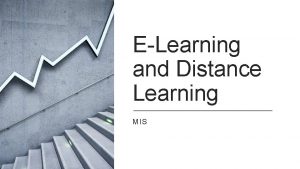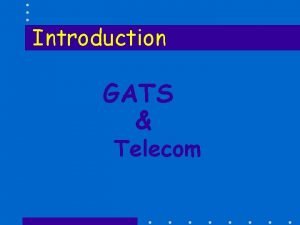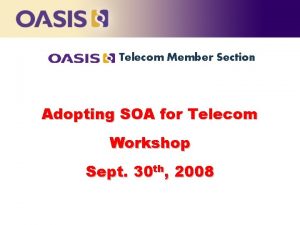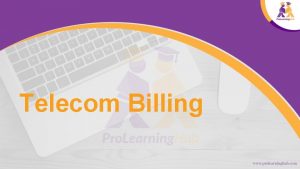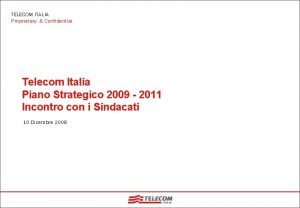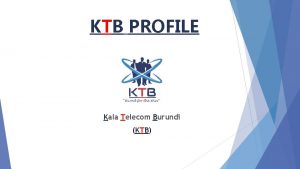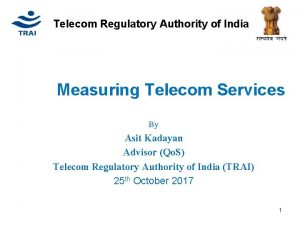elearning in Telecom Adopt new learning techniques and


























- Slides: 26

e-learning in Telecom Adopt new learning techniques …. and Enjoy the success from the heart… 1 2 3 4 5 6 7 8 9 0 HR / Training & Development Dept. Mobi. Nil, The Egyptian Company for Mobile Services 1 December 2004

e-learning: “To e or not to e…” To answer the ultimate question of going for e-learning or not, each organization must identify it’s state with respect to: @ e-learning Knowledge @ Adoption Capability @ Willingness and Urge

e-learning Knowledge q What is e-learning all about? q e-learning Evolution q e-learning Styles q Uses of e-learning

What is e-learning all about? Distance learning is an earlier term for e-learning…… @ is education or training that uses technology @ enables employees to learn at their work computers without traveling to a classroom @ has instructional objectives and helps taking employees step-by-step in the topic

What is e-learning all about? (cont’d) e-learning… @ is NOT similar to reading a document of a book @ does NOT conflict with classroom training; they can blend together “Blended Learning” is learning that combines components of e-learning on the Internet with other learning methodologies like CD-ROMs, classroom training or books

What is e-learning all about? (cont’d) e-learning encompasses: § § § § § Virtual presentations and lectures Virtual interaction with people Inviting guest speakers Whiteboard technology Web books or training manuals Simulations and games Virtual interaction with real things Virtual reference library Assessments and quizzes Tracking and reporting Techniques differ…. instructional design is what matters!

What is e-learning all about? (cont’d) Steps for setting up an e-learning system: 1. Figure out what you need e-learning for 2. Get the system set up on a small scale 3. Communicate to the students 4. Deliver the training 5. See if it really works in your environment 6. Expand the scale

e-learning Evolution… Videos /Audiotapes Computer-based self-paced training (text-based) Computer-based self-paced (with multimedia) E-learning via the Internet Blended learning (integrating all together with the classroom)

e-learning Styles… 1. Synchronous Learning 2. Self-directed Learning 3. Asynchronous (Collaboration) Learning There is no perfect style!

Synchronous Learning - Instructor and all the students meet over the internet at the same time and are connected by technology that acts like real-time interactive audio and video. - All on-line participants can interact together

Self-directed Learning - Student acts alone and works through the materials that are delivered to him/her over the internet. - There is NO instructor or group of peer students to communicate with.

Asynchronous (Collaboration) Learning - Instructors and students DON’T meet at exactly the same time. - Instructor and students interact by exchanging messages (bulletin board or team room)

Uses of e-learning… § § § § § Product knowledge Business tools training Technical certification training Technical skills training Awareness training New hire training New job role training Professional competency training HR benefits training On-going professional training e-learning can generally be used in all areas; however it is more effective in some than others

Uses of e-learning…(cont’d) Highly used in: ü Delivering mandatory knowledge ü Voluntary training to gain new skills for current or future job opportunities ü Rapid training rollout: with accelerated product cycles, you can’t wait to roll out training over months ü Handling shortened knowledge lifecycles: today knowledge can go out of date in a matter of months

Adoption Capability q Technical Aspect q Financial Aspect q Human Aspect

Technical Aspect… @ Internet / Intranet Access: Three options to run it… - Private intranet - Public system - Private access to a shared system @ Learning Portal @ Individual PCs (with web cams; headphones & mics)

Financial Aspect… @ Cost Components: § § Making the product Marketing the product Delivering the product Administrating the whole process (indirect cost: schedules, system maintenance, downloading courses, etc. )

Human Aspect… @ Culture: People’s ability to cope with change @ Availability of new instructor skills for teaching/controlling classes at a distance @ Staff Profile (age, skills, familiarity with new technology, exposure to latest technology trends) @ Management expectations, leadership, support, motivation and willingness to manage change

Willingness and Urge q Facts & Figures… q Why e-learning? q Which ‘e’-solution should I go for… q Are we a good candidate? q Case Study: Mini Business Launch Training q e-learning Demo

Facts & Figures… Did you know that…. - IBM achieved $375 M from its use of e-learning in 2001. - Training magazine reports that corporations can save 50 -70% of their overall training costs by replacing traditional training with e-learning. - Initial costs range from $5, 000 to more than $ 1 million depending on the complexity of the application & number of seats.

Facts & Figures…(cont’d) In a study conducted by ASTD in Y 2002: - 52% of the technology-based courses were web-based. - 38% preferred on-line training over classroom. - Delivery via learning technologies increased in all organizations to 29%. - Delivery via learning technologies increased in Technology organizations to 25%. - Delivery via learning technologies increased in Middle East to 10% compared to 18% in Japan & US; and 8% in Africa.

Facts & Figures…(cont’d) - Most successful e-learning courses are those that are well advertised, championed, and provided during work hours. - Compulsory nature of mandatory courses makes marketing and incentives less necessary for acceptance. - Blending e-learning with other complementary forms of instruction to attract those who may be uncomfortable with learning via technology is recommended. - Creating an e-learning culture that encourages and appreciates e-learning is recommended.

Why e-learning? Cost Saving: employees can learn without traveling to class. Most of the short-term savings are in the travel and living costs. Learning Quality: employees can learn at their own convenience. More Value: companies can provide more training.

Which ‘e’-solution should I go for? Before selecting the e-learning solution that best suits your company, consider the following: § Learning problem/budget § Number of students § Student time available for training § Time to build § Deadline for training everyone § Long-term versus short-term shelf life § Starting and ending skill levels § Need for an instructor § Need for collaboration (communication and interaction) § Measurement needs Calculate your ROI based on the above elements

Are we a good candidate? If we are… @ high-tech companies where engineers are expected to learn fundamentally new skills every couple of years. @ training a geographically dispersed work force with employees in many different cities. @ initiating programs that often require many employees to learn new things in a short period of time. @ readily connected to the internet and intranets.

Are we a good candidate? If we … @ have short product life cycles. @ run training sessions between 2 -3 hours maximum. @ have a workforce that is well-exposed to latest technology trends. @ have training where interaction with other participants is not necessary. Then e-learning is a great solution!
 Telecom elearning
Telecom elearning Remedial teaching is
Remedial teaching is Why did chevron adopt bpi
Why did chevron adopt bpi Adopt uskids
Adopt uskids Chapter 5 section 1 cultures of the mountains and the sea
Chapter 5 section 1 cultures of the mountains and the sea Chapter 14 section 1 the search for spices
Chapter 14 section 1 the search for spices Cuadro comparativo e-learning b-learning m-learning
Cuadro comparativo e-learning b-learning m-learning Bsc and msc in telecom
Bsc and msc in telecom Telecom mergers
Telecom mergers Fonction technique scooter
Fonction technique scooter Ala market from apex telecom
Ala market from apex telecom Eads telecom
Eads telecom Project management telecommunications
Project management telecommunications Telecom management vendor
Telecom management vendor Maysip telecom
Maysip telecom Rating and billing manager
Rating and billing manager Sigma telecom chile
Sigma telecom chile Telecom traffic
Telecom traffic Hyundai digital door lock
Hyundai digital door lock Telecom service catalog
Telecom service catalog People caring telecomitalia
People caring telecomitalia Oa telecom italia
Oa telecom italia Parcerias doc telecom pt
Parcerias doc telecom pt Firma digitale telecom
Firma digitale telecom Anda telecom lan extender
Anda telecom lan extender Cost drivers telecom industry
Cost drivers telecom industry Synapses telecom
Synapses telecom
